This 7-ingredient Italian cheesecake recipe is a fantastic dessert. Soft and very creamy, it leaves the most wonderful aroma in your kitchen, lasts several days, and cuts like a dream. It's crustless and made with 100% ricotta cheese.
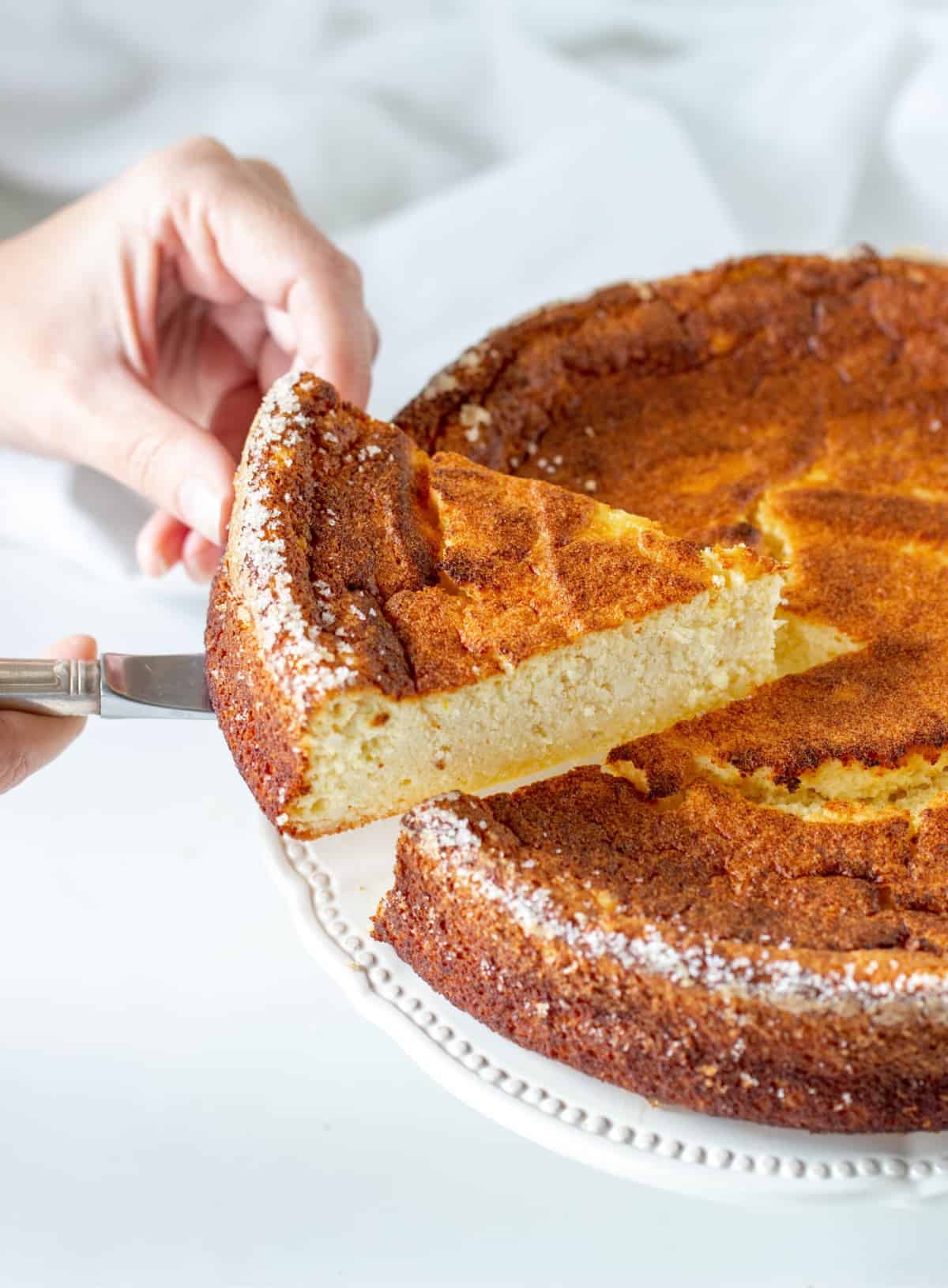
Some years ago, I would've said that if it didn't have cream cheese, it couldn't be called a cheesecake, period. My cheesecake recipes were simple, with no flour or cornstarch.
Nowadays, I'm more flexible and don't need to be such a purist. My strong Italian heritage and food culture make me love all things ricotta. So this recipe today (similar to a Sicilian cheesecake) and the classic ricotta cheesecake are a must in this blog and some of my personal favorite desserts.
Besides, if you look at how this gorgeous cake comes out of the oven, with its deep golden color and fantastic aroma, you'll understand why I'm such a fan.
It cuts like a dream. Even at room temperature, this cheesecake has the right firmness and holds its shape amazingly well.
The simple part is that the ingredients are everyday staples and, except for beating the egg whites separately, you just mix everything without much detail.
And it has no crust. Similar to some recipes for Sicilian cheesecake.
Reader review
I’ve made this recipe about 5 times now and it comes out perfect each and every time. It’s absolutely delicious! Fantastic!!!! Thanks so much for this recipe.
⭐️ ⭐️ ⭐️ ⭐️ ⭐️
- Carolyn
Step-by-step VIDEO
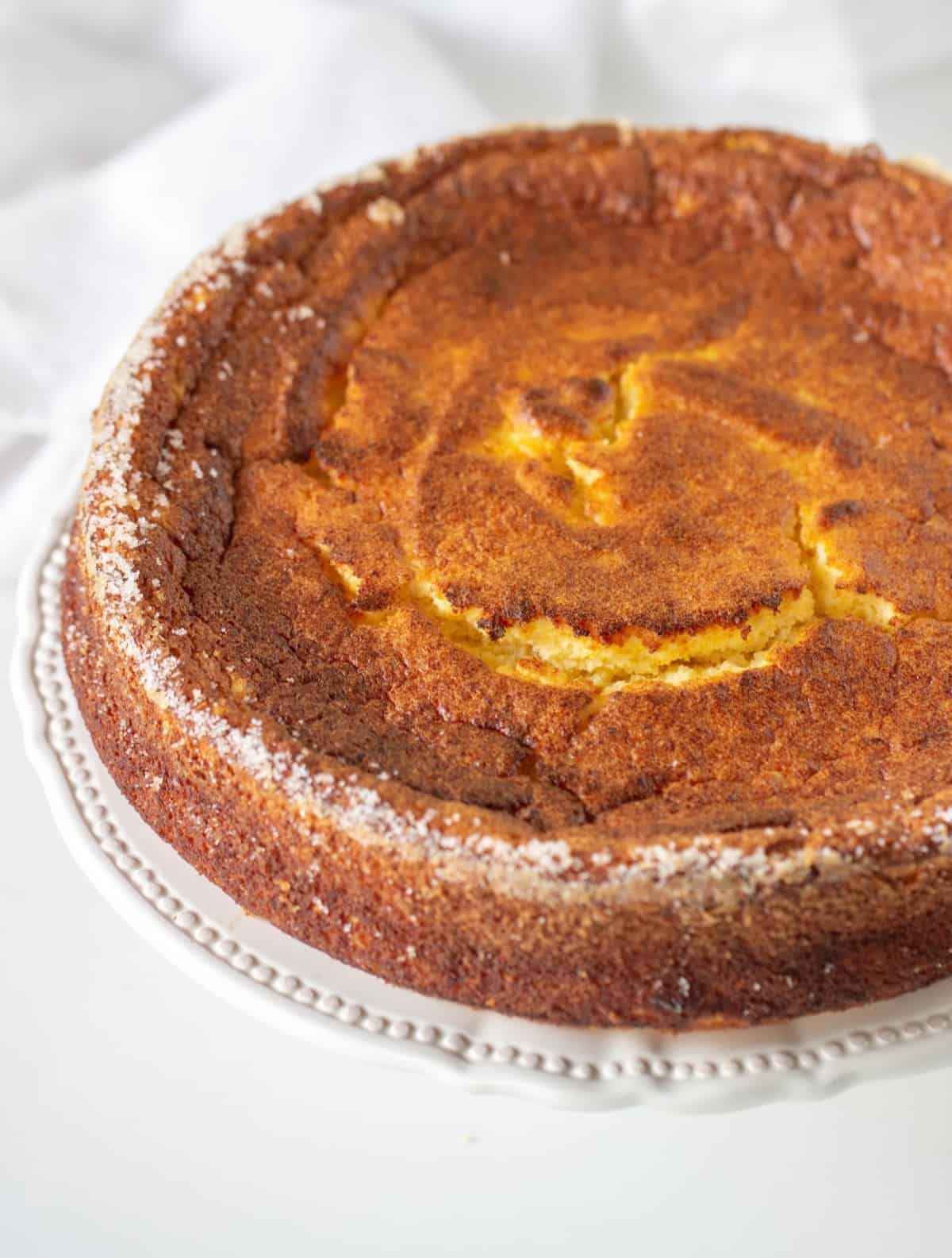
Ingredient list
- Ricotta: use regular, full-fat, whole-milk ricotta cheese.
- Eggs: fresh, large.
- Granulated sugar.
- Flour: a little bit of all-purpose flour is used as a binding agent to give the cheesecake more structure.
- Salt.
- Citrus zest: I used orange for this one, but lemon works very well.
- Vanilla extract.
Quantities are listed on the recipe card towards the end of this post. The Ingredients page has more details and lists the brands we use.
What is ricotta cheese?
Ricotta is a soft, grainy cheese made from cow's milk in this case (though it can also be made with goat, sheep, or buffalo milk).
I use regular soft ricotta (image below), which is sold in supermarkets and specialty stores, for all of my recipes.
It's creamy, moist, and has an almost sweet taste.
Quality varies according to brands, and you can find some with additives to make it thicker. I try to buy original ricotta sourced from good small producers. It tastes much better, and I like the consistency more.
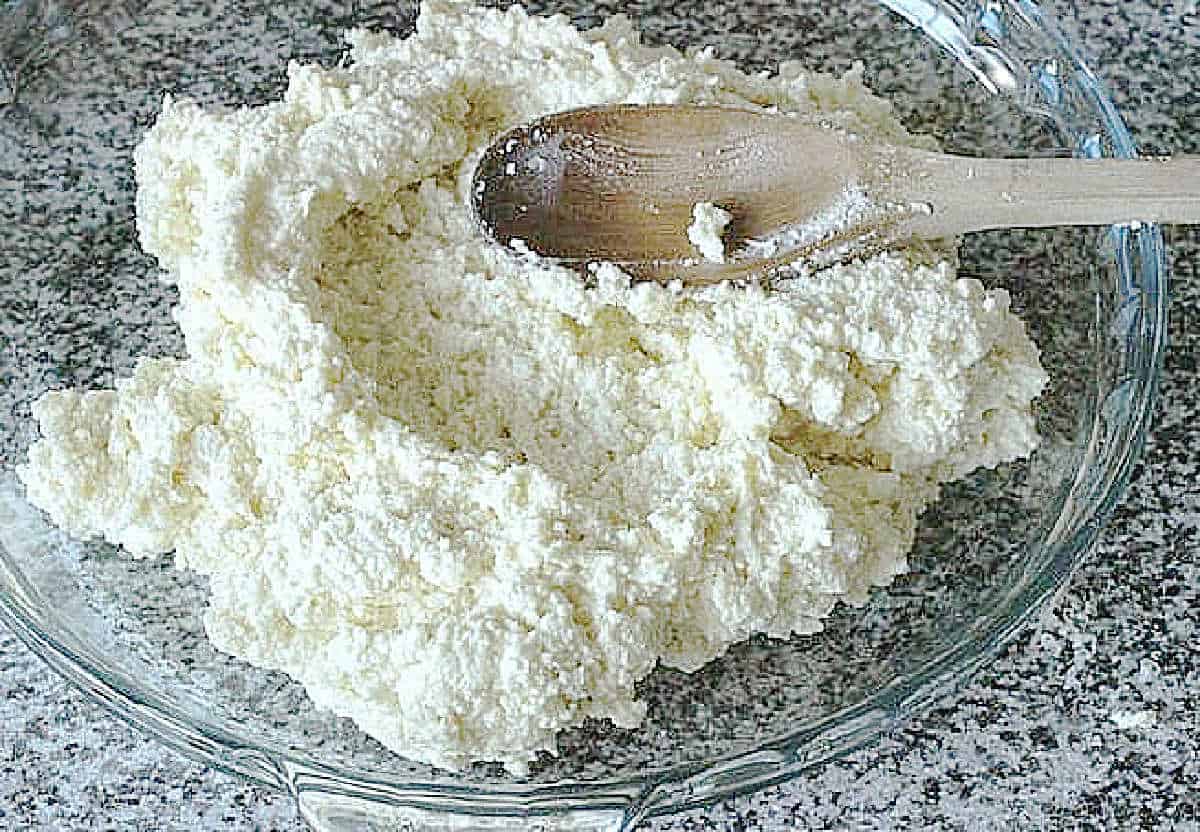
Ricotta vs. cottage cheese
Though they might look somewhat similar and can, ricotta and cottage cheese are different.
Ricotta is made from the whey left when the curds are separated from the milk or cream to make cheese, while cottage cheese is made from the curds. Their textures and flavors are different.
Difference between ricotta and cream cheese
Both are soft cheeses, but ricotta is a grainy cheese while cream cheese is smooth. The amount of salt is also different, and ricotta tends to be a tad sweeter.
Substitution
Though for this recipe, you should get the ricotta cheese (it is, after all, a ricotta cheesecake), you can use cottage cheese that has been processed with some cream cheese.
Cottage cheese can be too watery. If that's the case, drain it on a strainer with a cheesecloth or clean kitchen towel over a bowl.
How to make a crustless cheesecake
- It does not require a water bath, which can make some people nervous because some water might get into the batter.
- Separating the egg yolks from the whites might be the only part that takes a little more time. The whites are beaten separately and then added at the last moment. They give the cheesecake a light texture.
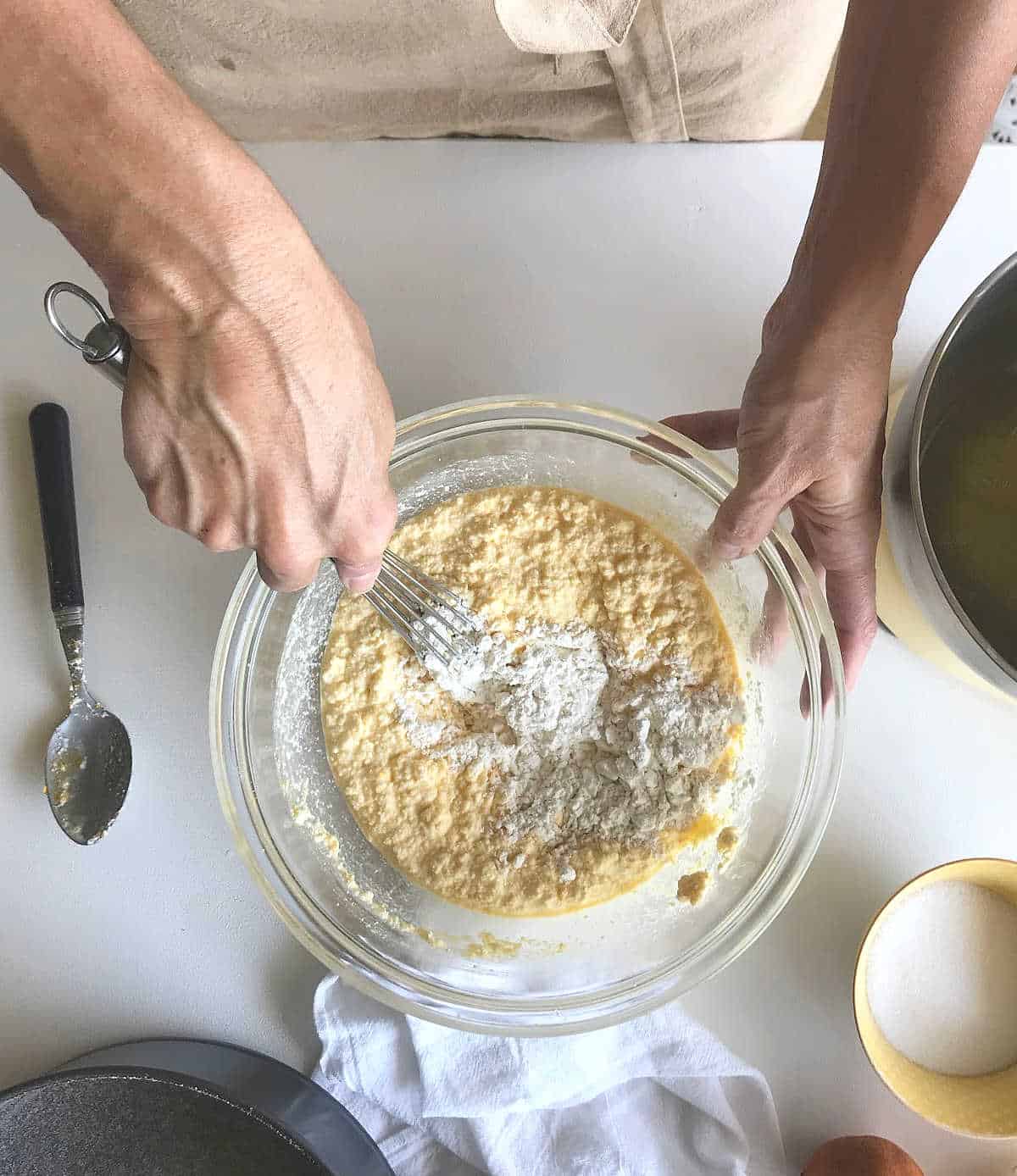
Egg whites
- Use an electric mixer.
- Have them at room temperature. It's the way to maximize the volume when they are beaten.
- How stiff should you beat the egg whites? I recommend medium peaks that are still unctuous. That way, the batter is more fluid, and the cake is creamier.
- Incorporate them gently but without the excessive care that other recipes sometimes need. This is a more forgiving recipe.
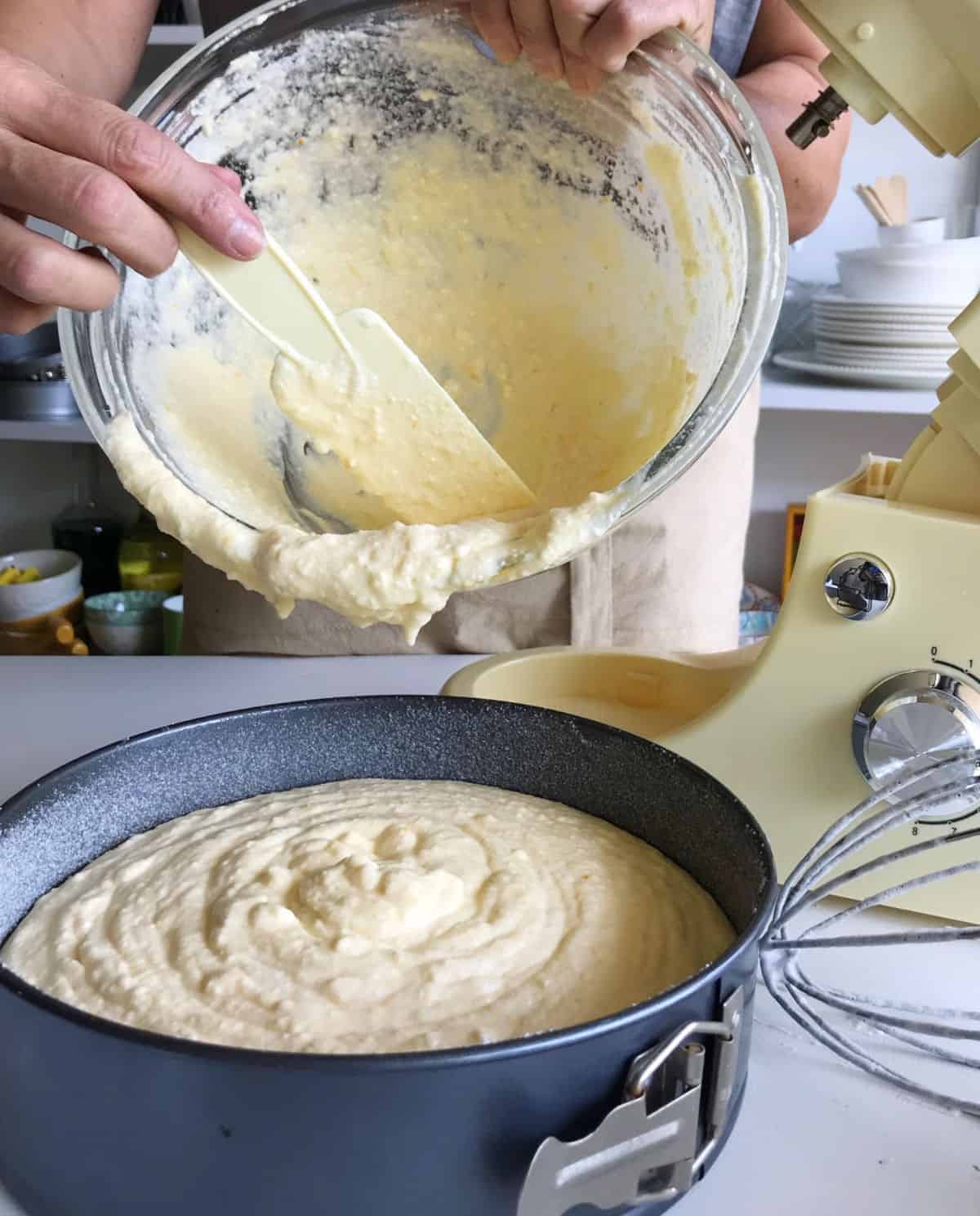
It's done when the top is golden, the edges are set, and the center still jiggles slightly. A toothpick or cake tester inserted in the center should come out almost clean.
Yes, that's what I recommend. It will get too soft if left at room temperature for too long, and it's a soft cheese, so the refrigerator is the best place to keep it.
It keeps for 3 days, well wrapped and refrigerated.
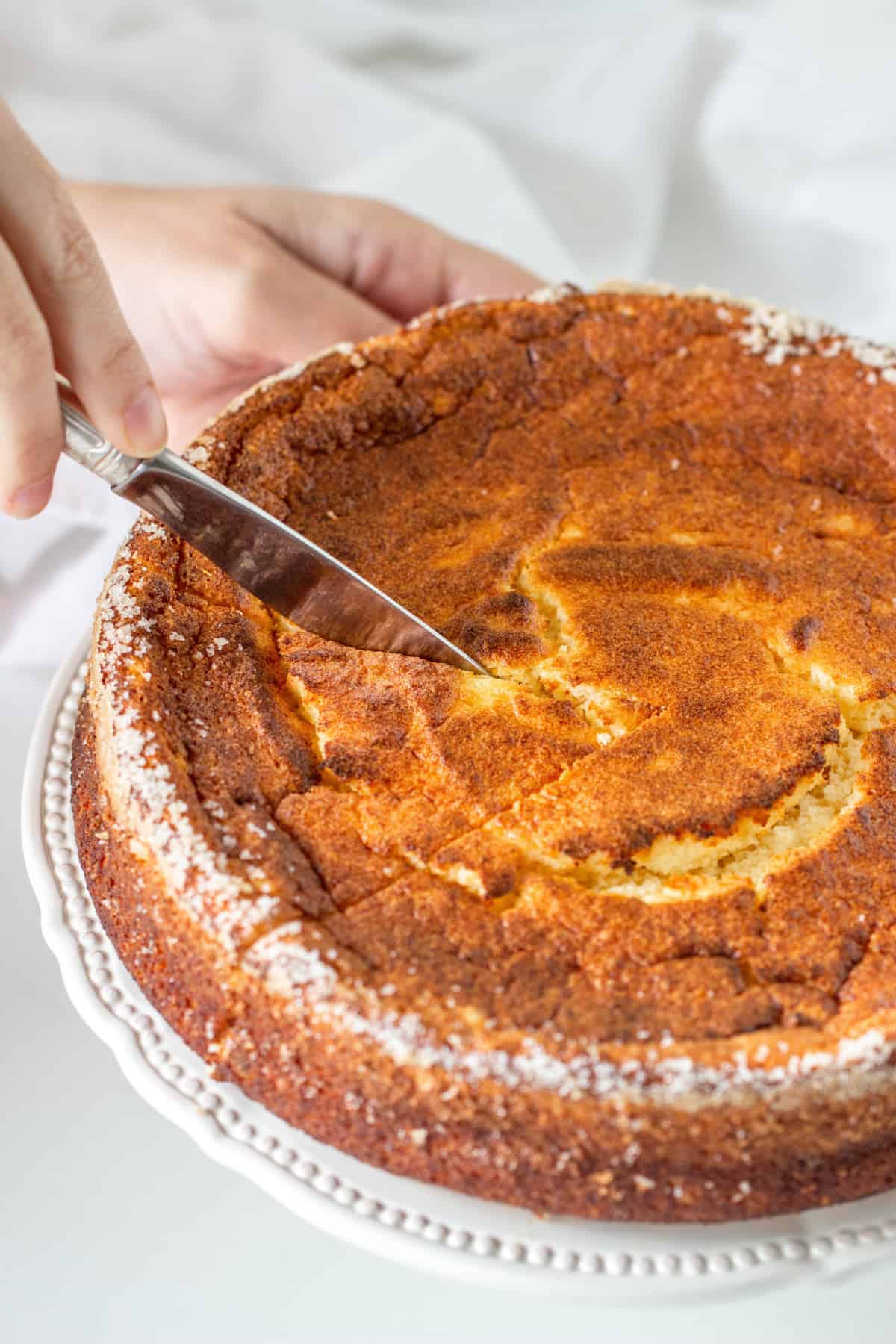
Kitchen Notes
- Organization: read the recipe first and ensure you have ingredients at the correct temperature, equipment, and enough workspace. This will make the process so much easier.
- Baking time: keep in mind that all ovens and pans are different, even if they look the same or very similar. The baking time in my recipes is as accurate as it can be, but it might take you more or less time. You can use a thermometer(like the OXO oven thermometer) to check that your oven is at the right temperature. I recommend you keep track of how your oven works and what tiny details you might need to adjust.
- Storing: this cheesecake lasts for several days in the fridge. I ate it after almost a week, and it was delicious. But the coldness of the refrigerator dries it up a bit every day (it's what refrigeration does to all baked goods), so my advice is up to 3 days, well wrapped in plastic wrap.
- Freezing: I don't recommend it as the texture changes quite a bit for my taste. But you can if you want to. Make sure it's well wrapped. I would freeze just one slice to try at first and see how it goes.
- Serving: we like it plain, but, for a more sophisticated presentation, serve it with a dollop of whipped cream and fresh berries.
- Individual cheesecakes: use small springform pans and reduce the baking time, adjusting to the size of your pans.
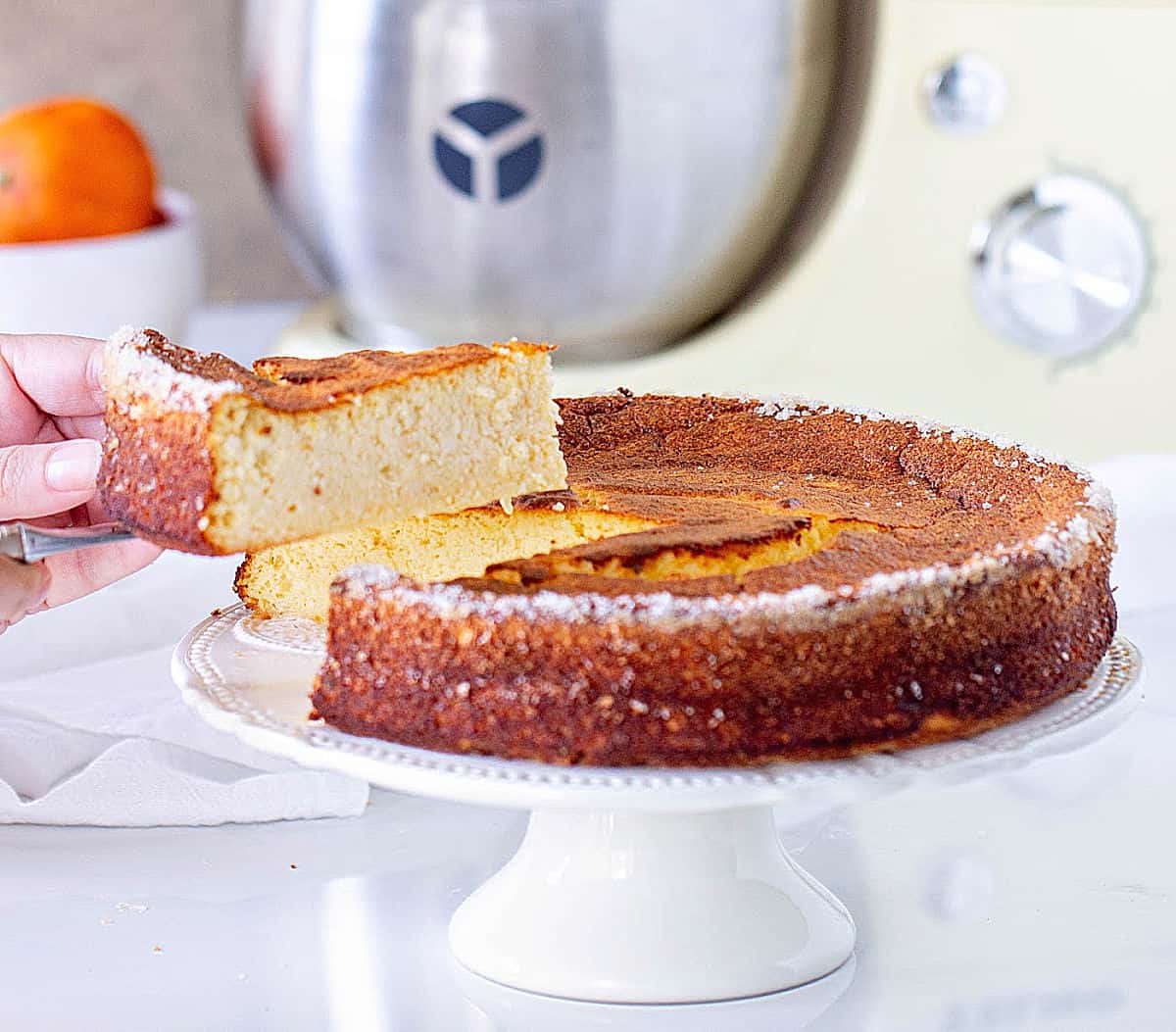
Flavor substitutions
- Citrus, use your favorite: lemon, lime, tangerine, a mix of all of them, you name it.
- Ground spices like cinnamon, cardamom, nutmeg, or pumpkin spice mix. Whatever you love more.
- Extracts (coffee, aniseed, almond, maple, there are so many to choose from)
- Liquors like Cointreau or Grand Marnier (orange), Frangelico (hazelnut), Amaretto (almond), Limoncello (lemon), or any other sweet or fruity one you like.
- A combination of the above, maybe almond extract and spice, or cinnamon with orange zest.
Variation: lemon ricotta cheesecake
I know lemon is a huge favorite when it comes to cheesecakes. So, I'm leaving you the simple way to make this lemon ricotta cake.
- Substitute the orange zest for lemon zest.
- Adding lemon juice: combining zest and juice gives it a more intense and balanced flavor. But don't overdo it with the juice, or you'll change the texture. You can add up to 1 tablespoon of lemon juice. If your cheese is dry, this would be perfect, but if your ricotta cheese is on the wetter side, I suggest you let it drain for a while.
Related recipes you might like:
If you love cheesecakes as much as I do, this is a different recipe that you will love for its versatility (flavorings) and simplicity, lack of crust and easy cutting.
It's a wonderful recipe slightly adapted from Martha Stewart's Baking Handbook.
Let me know in the comments below if you made this recipe and loved it and if you had issues so we can troubleshoot together. I love to hear what you think, always. Thanks for being here. It's much appreciated.
You might also consider subscribing to our FREE Baking the Best email series and our regular newsletter. Or connect via Facebook, Instagram, and Pinterest.
As an Amazon Associate, I earn from qualifying purchases. Please read my disclosure policy.
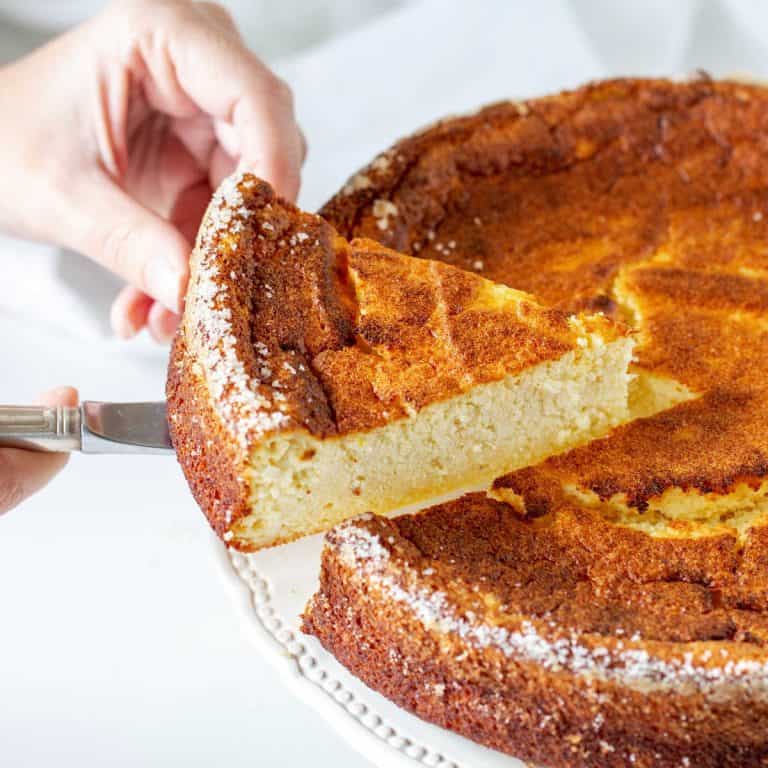
Baked Ricotta Cheesecake (no crust)
This 7-ingredient ricotta cheesecake recipe is soft and very creamy. It leaves the most wonderful aroma in your kitchen, lasts several days, and cuts like a dream. A great addition to Mother's Day and Easter brunch tables, small Spring weddings and picnics.
- Total Time: 1 hour 5 minutes
- Yield: 8 servings
Ingredients
- ¾ cup white granulated sugar + more for the pan
- 1 ½ pounds whole milk ricotta, at room temperature
- 6 eggs, at room temperature
- ¼ cup all-purpose flour
- ¼ teaspoon salt
- 2 tablespoons orange zest (2 oranges)
- ½ teaspoon vanilla extract (optional)
Instructions
- Preheat the oven to 350ºF /180ºC.
- Butter a 9-inch round cake pan with a removable bottom and dust with sugar, shaking off excess.
- Mix ricotta, orange zest, and vanilla (if using) in a large bowl. You can beat this for a minute or so if you want a smoother texture. I don’t do it.
- Add the flour, HALF the sugar, salt, and mix well.
- Separate eggs, one by one, adding the yolks to the bowl with the ricotta mixture and the whites in another clean (very clean and dry, with no traces of oil or grease) bowl. I use the stand mixer for the whites and put them directly in the mixing bowl. Try using an extra small bowl for cracking each egg so you don’t risk the tiniest bit of yolk getting into the whites since it will prevent them from beating as they should.
- Beat whites for 30 seconds and gradually add the remaining HALF of the sugar while beating at medium speed.
- Keep on beating at high speed until it foams and triples in volume, but medium-soft peaks form when the beater is lifted.
- Add the beaten egg whites to the ricotta mixture with a spatula in 3 parts, adding the next part after almost incorporating the last part. This way, you don't overmix the whites and they keep some volume.
- After the third part is added, make sure the mixture is combined. Don’t overmix it so it rises well in the oven and has airy texture.
- Put in the prepared pan, smoothing the surface, and bake for 50-55 minutes, or until it’s golden, but the center of the cheesecake still wiggles when lightly shaken, similar to brownies.
- Remove from oven and let cool for 10 minutes on a wire rack, then run a smooth knife around the sides to ensure it is not stuck.
- Let cool completely in the pan before transferring it to the serving plate. I like to wrap the pan in plastic and refrigerate the cheesecake for a few hours or until the next day before eating.
Notes
Baking time: keep in mind that all ovens and pans are different, even if they look the same or very similar. The baking time in my recipes is as accurate as it can be, but it might take you more or less time. You can use a thermometer(like the OXO oven thermometer) to check that your oven is at the right temperature. I recommend you keep track of how your oven works and what tiny details you might need to adjust.
Egg whites: beat the whites to medium-soft peaks; that way, the batter is more fluid and the cake is creamier. Have them at room temperature, that is the way to maximize the volume when they are beaten.
Storing: his ricotta cheesecake lasts for several days in the fridge. I ate it after almost a week, and it was delicious. But the coldness of the refrigerator dries it up a bit every day (it's what refrigeration does to all baked goods), so my advice is up to 3 days, well wrapped in plastic wrap. I don't recommend freezing it.
Freezing: I don't recommend it as the texture changes quite a bit for my taste. But you can if you want to. Make sure it's well-wrapped. I would freeze just one slice to try at first and see how it goes.
For variations & substitutions read the post above.
- Prep Time: 15 minutes
- Cooling time:
- Cook Time: 50 minutes
- Category: Cakes
- Method: Baking
- Cuisine: Italian
Nutrition
- Serving Size: ⅛
- Calories: 288
- Sugar: 19.1 g
- Sodium: 197.6 mg
- Fat: 14.6 g
- Carbohydrates: 24.6 g
- Fiber: 0.1 g
- Protein: 14.7 g
- Cholesterol: 182.9 mg


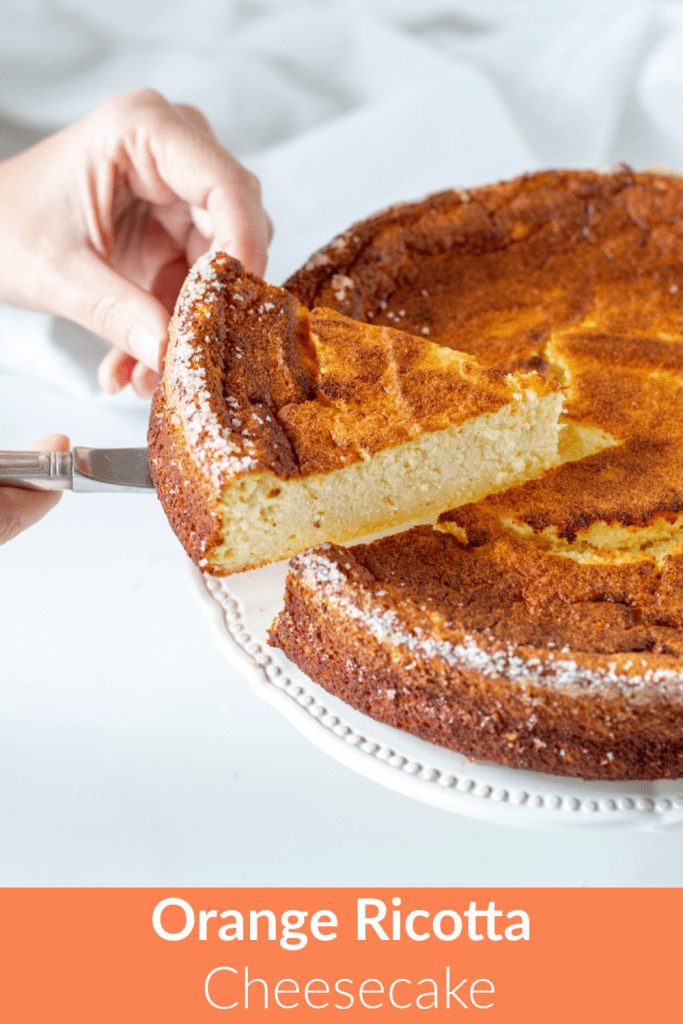
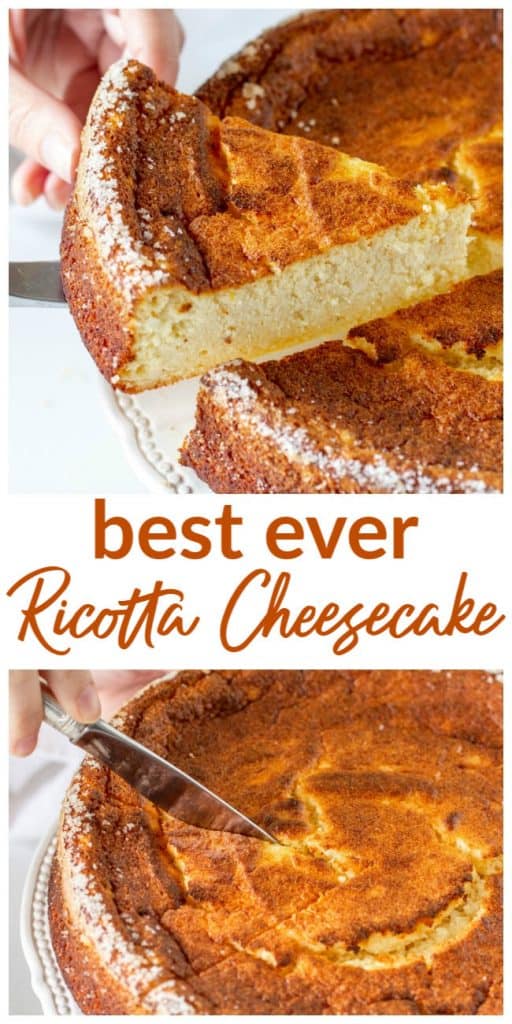
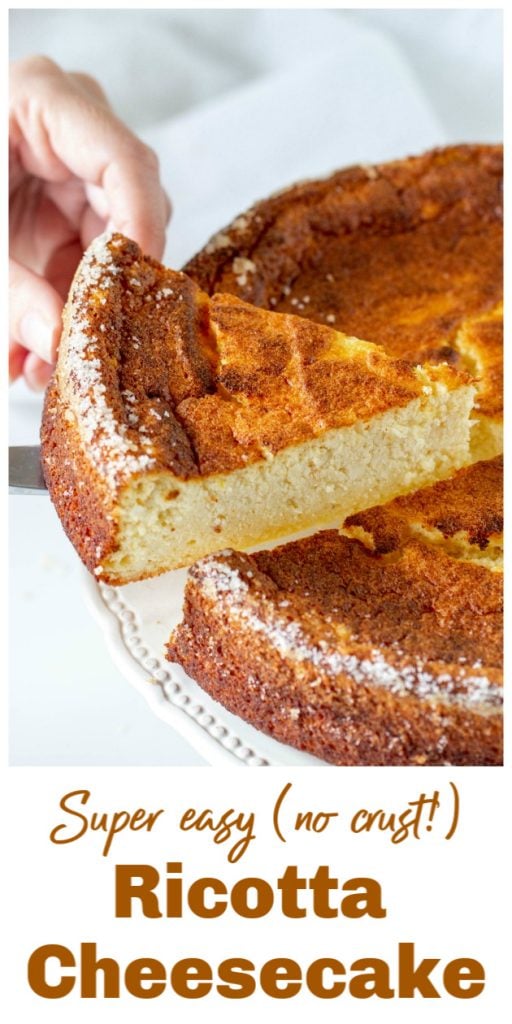
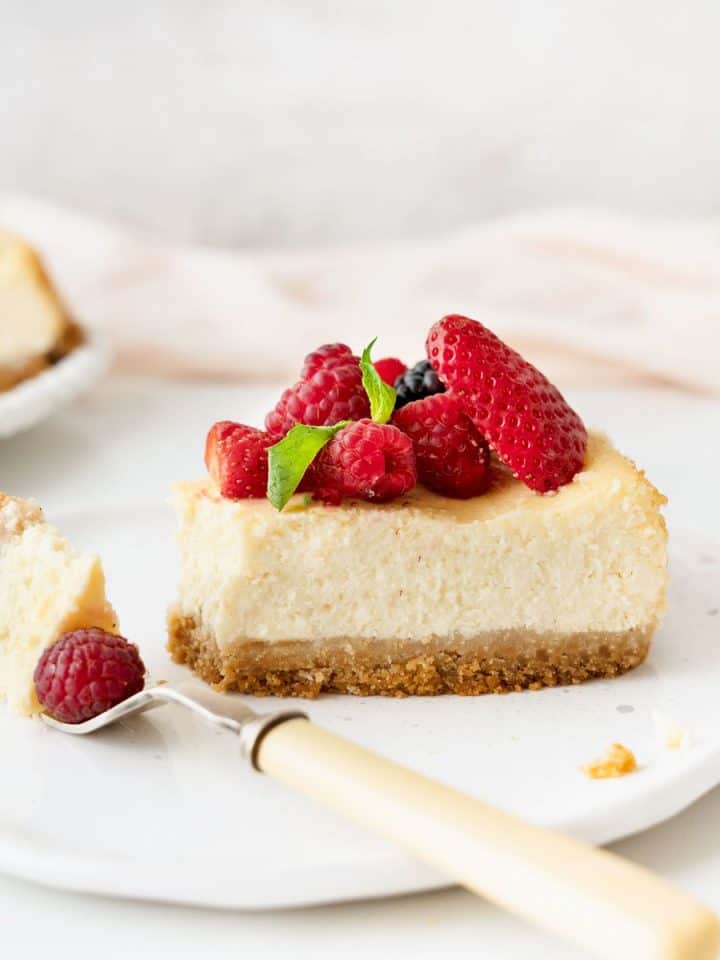
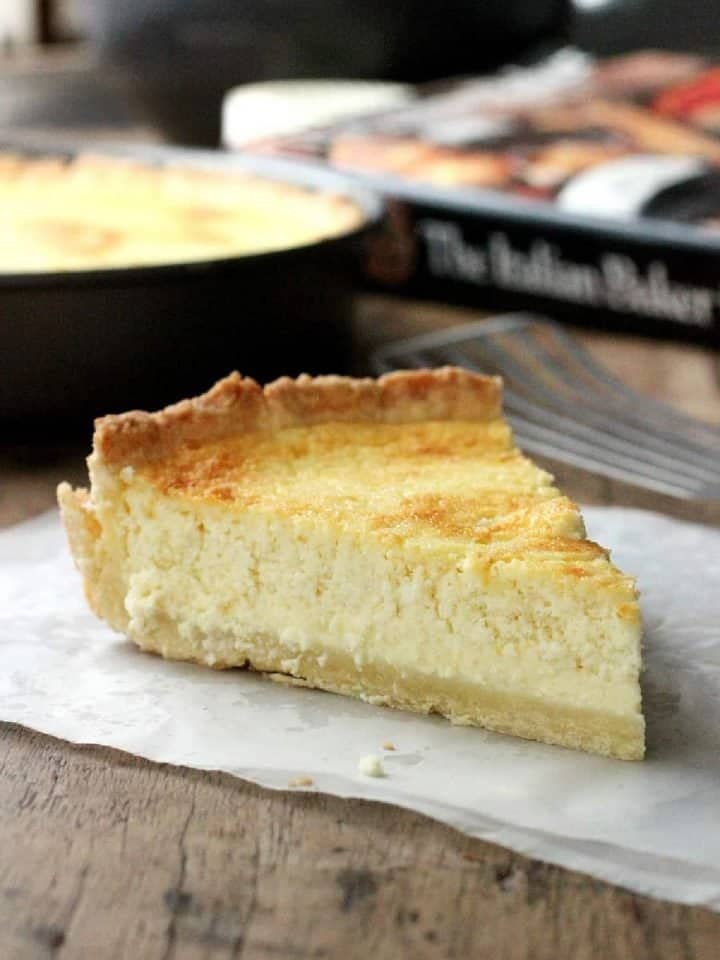
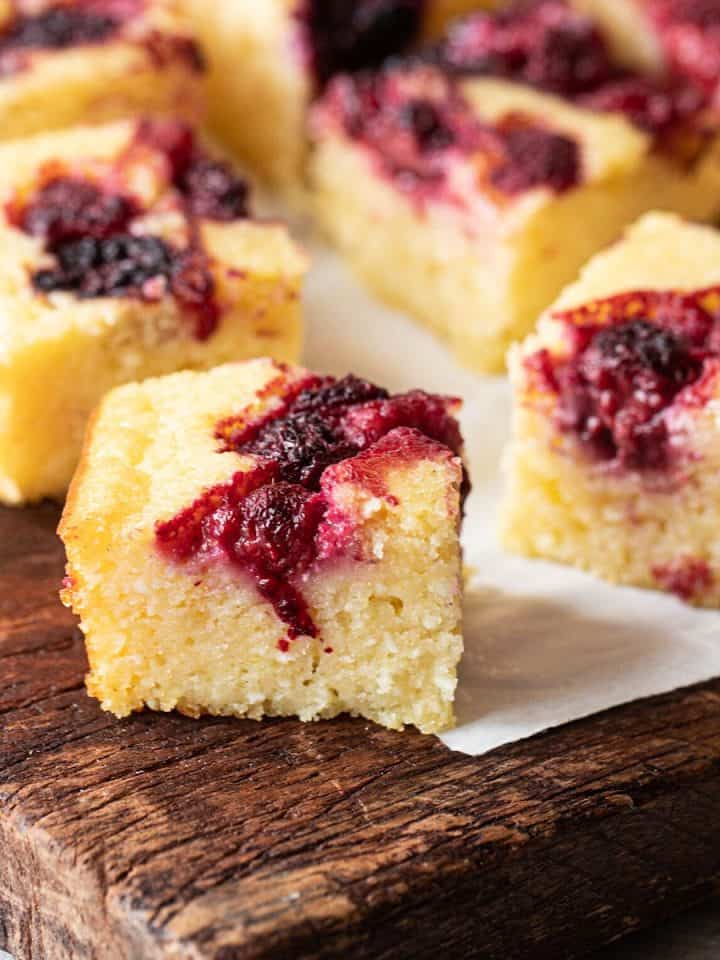
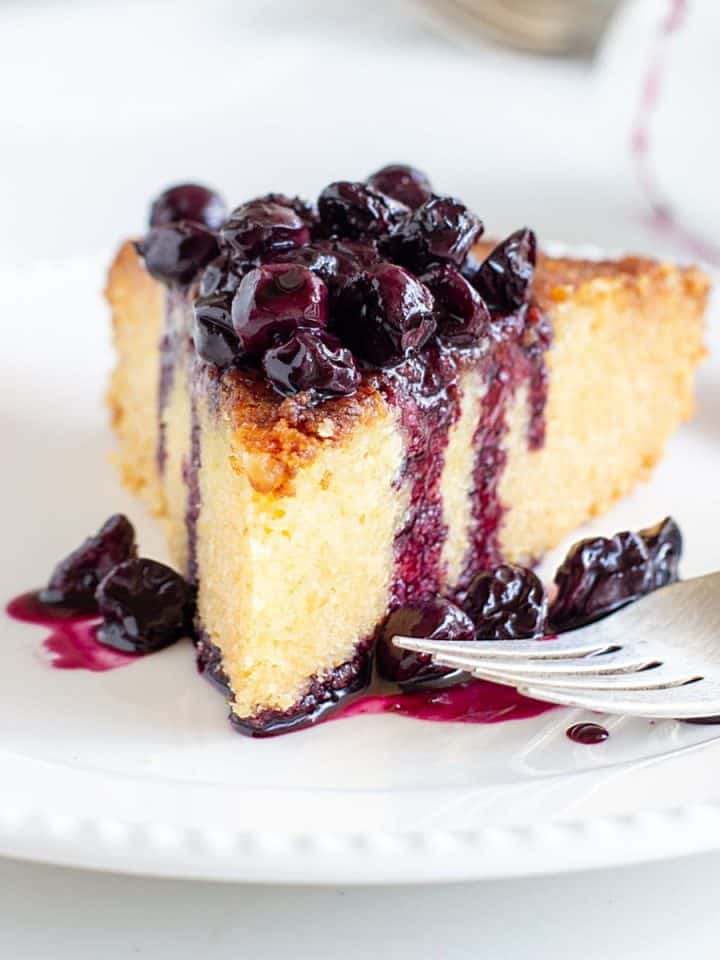
Leonie Whitfield says
My cheesecake collapsed to half its height. My friend made it and it was perfect. I beat the egg yolks and flour into the ricotta mixture, didn’t hand mix. Oven temperature fine. What went wrong? Thank you
Paula Montenegro says
Hi Leonie, overbeating is usually the reason a cake collapses. This cheesecake does deflate a little as it cools down, but not to half its height.
Leonie Whitfield says
Yes I over beat it. Will try again - this time following the instructions perfectly.
Friends said it tasted like a lemon mousse cake. The solidity of true baked cheesecake was lost.
Ash says
Hey Paula, I’ll be baking this Wednesday night for a solstice dinner party Thursday night. I’d like to do an orange honey combination. Should I still use the full 3/4 c sugar, or should I ratchet back on that? I’m planning on garnishing with blackberries and basil. Thanks for the inventive recipe and suggested customization ideas!
Paula Montenegro says
Hi Ash! I never made it with honey and this is already a moist cheesecake. So I'm not talking from experience with this particular recipe, but using honey might make it too moist. I would substitute some of the sugar, not all of it. Maybe 1/3 of the amount. You can add a drizzle on top when you serve it to enhance the flavor.
Ash says
That’s a great idea Paula. Or maybe I can just use it the way you add the liquor (in addition to the sugar). I’ll think on this and let you know how it goes. Thanks!
Dawn E. Gamboa-Nappi says
I made this for my husband's birthday. His Mom always made ricotta cheesecake. I tweaked her recipe by using orange zest, more vanilla. This is almost the same recipe. It was delicious. Making again for Father's Day! I never separated the eggs. I will today when I make it again.
retrolady says
i have made this cake 5 times in 5 months my husband loves it!!!!
Lisa says
It's awful how hard is to finally get to the recipe.... it should be on the top not at the end as most of us do not have time to read all the stories ... Also the crazy advertisement covers everything so good luck to read anything on your phone. We truly are an insane society unable to share recipes without bombarding us with a constant nonsense. Time to go back to basics without straining our eyes (constant flashing adds) and focus on recipes.
Paula Montenegro says
Hi Lisa, there is a Jump to Recipe button at the top, after the title, so you can skip the post and go straight to the recipe.
The post itself has valuable information and details for less experienced bakers that need more guidance. I think it's important to cater to all of my readers.
I don't take ads placings lightly, and am constantly finding a balance between them and sharing free recipes. But without monetization this blog wouldn't be possible. It takes a lot of money, time and other resources to create 'free' content.
Have a great day.
Evelyn says
I’ve been looking for an all ricotta cheesecake recipe and I’m so excited to make this for my mom’s birthday!
I only have two 6” springform pans.What would you recommend for baking time since it’ll be a deeper cake? Thanks so much!
Holly Cross says
Any way to stop this from cracking?
Paula Montenegro says
Hi Holly, is it happening in the oven or after you removed it? It can be due to a too high oven (you can check that the temperature is right with an oven thermometer).
You can add a pan with boiling water in the bottom of the oven to create a humid environment and add moisture.
retrolady says
awesome
Carolyn Dykas says
I’ve made this recipe about 5 times now and it comes out perfect each and every time. It’s absolutely delicious! I make my own ricotta cheese , let it drain well and so I add the juice from the orange. Fantastic!!!! Thanks so much for this recipe.
Dorina Szczepanski says
you forgot to add the egg yolks in!!
Paula Montenegro says
Hi Dorina, I didn't, it's in the step 5 of the instructions. They're even underlined to make it clear that they're added to the ricotta. Have a great day.
Terri Deane says
I cannot wait to try this delicious cheesecake! I'm not much of a baker, but you have laid this out in such a way as to give courage to a timid baker, so I thank you. I was wondering if you could tell me how much of a liquor should be added, and at what point? I want to do the lemon and add some limoncello, but I want to do it at the proper time. Thank you for this beautiful recipe and seasons blessing to you and yours.
Paula Montenegro says
Hi Terri, thanks for such a thoughtful comment! You can add the limoncello to the ricotta together with the zest. I would start with a tablespoon and see how it goes after it bakes, and adjust for future cheesecakes. Happy baking.
Terri Deane says
Thanks for your prompt reply - our son that's coming for the holidays is very excited about trying this cake. I just hope that I can do it justice. I'll let you know!
Orysia says
Can you substitute corn starch instead of flour
Paula Montenegro says
Hi Orysia, I didn't try it. But you probably can sub it with no major issues, as it's a small amount. You might get a denser texture.
Maribeth Southworth says
Well, two months later I finally got around to making this with my Bob's Red Mill gluten-free baking flour and it is delicious. I thought I had a 9 inch spring form pan, but it was 6 inches, so I put the excess in a pie plate. This was a trial run, for my husband, son and I, so I really didn't care how either looked.
I had no idea how long to bake the portion in the 6" pan, as it was so much deeper, and have not cut in to it yet, but once I buy a new 9 inch I will be set. The part in the pie plate is absolutely light and delicious. I will try the other tomorrow! Thank you for providing a gluten-free alternative that is delicious.
Ann says
thank you! finally a sicilian cheesecake with no cream cheese! my mom would make one every holiday and it was so worth waiting for but my mom unexpectedly developed Alzheimer's and i don't know where her precious recipe is. i am collecting my ingredients and can't wait to try this! ❤
Maribeth says
It's probably me, but I just need confirmation that none of the egg yolks are used here. The "Add the next part after almost incorporating the last part" confused me and I can't wait to make this, so just wanted to confirm. Thanks!
Paula Montenegro says
Hi Maribeth! You DO use the yolks and they go with the ricotta mixture. The egg whites are added in two or three parts afterward. I rewrote some sentences in the recipe card so it's more clear. Let me know if you have more questions. Happy baking!
Maribeth Southworth says
Thank you, Paula. I CANNOT WAIT TO MAKE THIS. I have celiac disease and my favorite Italian restaurant in New Jersey has a ricotta cheesecake that is divine and I bet this will be! Thanks for helping me with the directions!!!!
Megan says
Would love to make this, however, I can't find where in the recipe it lists how much ricotta to use.
Paula Montenegro says
Hi Megan, the amount is in the recipe card at the end of the post. It has always been there. You have a jump to recipe button underneath the title of the post so you can go directly to it.
paula lederman says
made this cake. used half ricotta and half cottage cheese. unfortunately the center was very runny so either it had too much liquid or I needed to bake it it longer. it did taste delicious though.
not sure what the cup equivalent measurement is for one pound
Paula Montenegro says
Hi Paula! Yes, cottage cheese is very different from ricotta as it's much wetter, so I'm not surprised the center was runny. Maybe it changed after you refrigerated it for several hours or a day? I hope so. Next time, drain it first so it's similar in texture to ricotta.